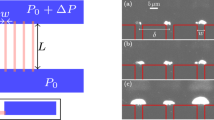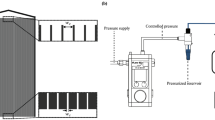Abstract
The clogging of porous media by colloidal particles is a complex process which relies on many different physical phenomena. The formation and the structure of a clog results from the interplay between hydrodynamics (flow rate and pore geometry) and the DLVO forces (particle–particle and particle–wall). In order to get a better understanding of this process, we study the clogging of a microfluidic filter, at the single pore level, and determine the influence of each relevant parameter separately. We show that in order to form stable clogs, colloidal particles have to pile up over a length in the flow direction roughly equal to the width of the pore. We found that there are two clogging regimes, which depend on the applied pressure. In the first one, at low pressures, the length of the clog within the pore and the number of particles that pass through the pore prior to clogging are constant. In the second one, for higher pressures, both quantities increase with the pressure. We also show that a higher ionic strength accelerates the clog formation, keeping constant the length of the clog.









Similar content being viewed by others
References
Agbangla GC, Climent E, Bacchin P (2012) Experimental investigation of pore clogging by microparticles: evidence for a critical flux density of particle yielding arches and deposits. Sep Purif Technol 101:42
Ai Y, Joo SW, Jiang Y, Xuan X, Qian S (2009) Pressure-driven transport of particles through a converging-diverging microchannel. Biomicrofluidics 3(2):022404
Auset M, Keller AA (2006) Pore-scale visualization of colloid straining and filtration in saturated porous media using micromodels. Water Resour Res 42(12):1–9
Bacchin P, Marty A, Duru P, Meireles M, Aimar P (2011) Colloidal surface interactions and membrane fouling: investigations at pore scale. Adv Colloid Interface Sci 164(1–2, SI):2
Bacchin P, Derekx Q, Veyret D, Glucina K, Moulin P (2013) Clogging of microporous channels networks: role of connectivity and tortuosity. Microfluid Nanofluid 17:1–12
Baumann T, Werth C (2004) Visualization and modeling of polystyrol colloid transport in a silicon micromodel. Vadose Zone 3(2):434
Bergendahl J, Grasso D (2000) Prediction of colloid detachment in a model porous media: hydrodynamics. Chem Eng Sci 55(9):1523
Brans G, van Dinther A, Odum B, Schroen CGPH, Boom RM (2007) Transmission and fractionation of micro-sized particle suspensions. J Membr Sci 290(1–2):230
Goldman A, Cox R, Brenner H (1967) Slow viscous motion of a sphere parallel to a plane wall—II Couette flow. Chem Eng Sci 22(4):653
Kuznar ZA, Elimelech M (2007) Direct microscopic observation of particle deposition in porous media: role of the secondary energy minimum. Colloid Surf A 294(1–3):156
Lin J, Bourrier D, Dilhan M, Duru P (2009) Particle deposition onto a microsieve. Phys Fluids 21(7):1–14
Mustin B, Stoeber B (2010) Deposition of particles from polydisperse suspensions in microfluidic systems. Microfluid Nanofluid 9:905
O’neill ME (1968) A sphere in contact with a plane wall in a slow linear shear flow. Chem Eng Sci 23(11):1293
Ryan JN, Elimelech M (1996) Colloid mobilization and transport in groundwater. Colloid Surf A 107:1
Sauret A, Barney EC, Perro A, Villermaux E, Stone HA, Dressaire E (2014) Clogging by sieving in microchannels: application to the detection of contaminants in colloidal suspensions. App Phys Lett 105(7):074101
Sharma MM, Chamoun H, Sarma DSR, Schechter RS (1992) Factors controlling the hydrodynamic detachment of particles from surfaces. J Colloid Interface Sci 149(1):121
Squires TM, Quake SR (2005) Microfluidics: fluid physics at the nanoliter scale. Rev Mod Phys 77(3):977
Torkzaban S, Bradford SA, Walker SL (2007) Resolving the coupled effects of hydrodynamics and DLVO forces on colloid attachment in porous media. Langmuir 23(19):9652
Weitz DA, Oliveria M (1984) Fractal structures formed by kinetic aggregation of aqueous gold colloids. Phys Rev Lett 52(16):1433
Wyss HM, Blair DL, Morris JF, Stone HA, Weitz DA (2006) Mechanism for clogging of microchannels. Phys Rev E 74(6):061402
Xu X, Sarder P, Li Z, Nehorai A (2013) Optimization of microfluidic microsphere-trap arrays. Biomicrofluidics 7(1):014112
Xuan X, Li D (2006) Particle motions in low-Reynolds number pressure-driven flows through converging-diverging microchannels. J Micromech Microeng 16(1):62
Acknowledgments
We acknowledge the support of the French Agence Nationale de la Recherche (ANR) (ANR-12-JS09-0003) and the CNES (Collmat) for their funding support. M.A. acknowledges the support of labex NUMEV (convention ANR-10-LABX-20).
Author information
Authors and Affiliations
Corresponding author
Rights and permissions
About this article
Cite this article
Dersoir, B., de Saint Vincent, M.R., Abkarian, M. et al. Clogging of a single pore by colloidal particles. Microfluid Nanofluid 19, 953–961 (2015). https://doi.org/10.1007/s10404-015-1624-y
Received:
Accepted:
Published:
Issue Date:
DOI: https://doi.org/10.1007/s10404-015-1624-y




